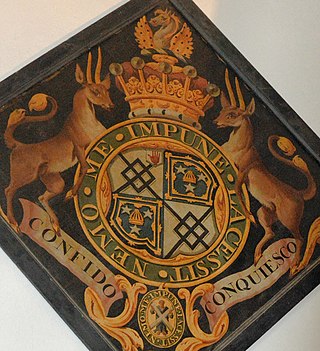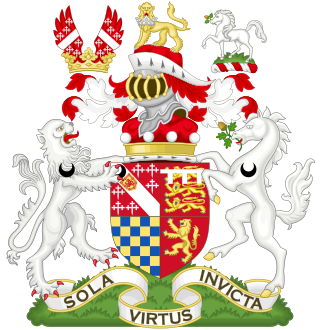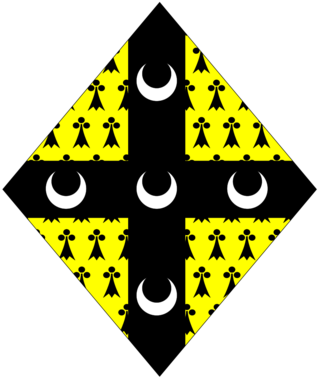Related Research Articles

Duke of Norfolk is a title in the peerage of England, and is the premier non-royal peerage. The seat of the Duke of Norfolk is Arundel Castle in Sussex, although the title refers to the county of Norfolk. The current duke is Edward Fitzalan-Howard, 18th Duke of Norfolk. The dukes have historically been Catholic, a state of affairs known as recusancy in England.

Earl of Suffolk is a title which has been created four times in the Peerage of England. The first creation, in tandem with the creation of the title of Earl of Norfolk, came before 1069 in favour of Ralph the Staller; but the title was forfeited by his heir, Ralph de Guader, in 1074. The second creation came in 1337 in favour of Robert de Ufford; the title became extinct on the death of his son, the second Earl, in 1382. The third creation came in 1385 in favour of Michael de la Pole. The fourth creation was in 1603 for Lord Thomas Howard, the second son of Thomas Howard, 4th Duke of Norfolk, by his second wife Margaret Audley, the daughter and eventual sole heiress of Thomas Audley, 1st Baron Audley of Walden, of Audley End in the parish of Saffron Walden in Essex. Howard was a prominent naval commander and politician and served as Earl Marshal, as Lord Chamberlain of the Household and as Lord High Treasurer. In 1597 he was summoned to Parliament as Baron Howard de Walden, and in 1603 he was further honoured, at the start of the reign of King James I, when he was created Earl of Suffolk. His second son the Hon. Thomas Howard was created Earl of Berkshire in 1626.

Earl of Berkshire is a title that has been created twice in the Peerage of England. It was created for the first time in 1621 for Francis Norris, 1st Earl of Berkshire. For more information on this creation, see the Earl of Abingdon and also the Earl of Lindsey. The second creation came in 1626 in favour of Thomas Howard, 1st Viscount Andover. He was the second son of Thomas Howard, 1st Earl of Suffolk, second son of the second marriage of Thomas Howard, 4th Duke of Norfolk. His mother was Katherine, daughter of Sir Henry Knyvett of Charlton in Wiltshire. Howard had already been created Baron Howard of Charlton, in the County of Wiltshire, and Viscount Andover, in the County of Southampton, in 1622. These titles are also in the Peerage of England. Lord Berkshire succeeded to the Charlton estate through his mother in 1638. He was succeeded by his eldest son, the second Earl. He had already in 1640 been summoned to the House of Lords through a writ of acceleration in his father's junior title of Baron Howard of Charlton. He had no sons and on his death in 1679 the titles passed to his younger brother, the third Earl. He represented Wallingford in the House of Commons. He also died without male issue and was succeeded by his great-nephew, the fourth Earl. He was the grandson of the Hon. William Howard, fourth son of the first Earl. In 1745 he succeeded his third cousin as eleventh Earl of Suffolk. For further history of the titles, see the Earl of Suffolk.

Earl of Carlisle is a title that has been created three times in the Peerage of England.

Earl of Dysart is a title in the Peerage of Scotland. It was created by King Charles I in 1643 for William Murray and has been held continuously since then by his relatives.

Earl Cadogan is a title that has been created twice in the Peerage of Great Britain for the Cadogan family. The second creation, in 1800, was for Charles Cadogan, 3rd Baron Cadogan.

Earl of Stradbroke, in the County of Suffolk, is a title in the Peerage of the United Kingdom. It was created in 1821 for John Rous, 1st Baron Rous, who had earlier represented Suffolk in the House of Commons.

Earl of Effingham, in the County of Surrey, is a title in the Peerage of the United Kingdom, created in 1837 for Kenneth Howard, 11th Baron Howard of Effingham, named after the village of Effingham, Surrey, where heads of the family owned the manor.

Baron Howard of Glossop, in the County of Derby, is a title in the Peerage of the United Kingdom, since 1975 a subsidiary title of the dukedom of Norfolk. It was created in 1869 for the Liberal politician Lord Edward Howard, the second son of Henry Fitzalan-Howard, 13th Duke of Norfolk. His grandson, the third Baron, married Mona Stapleton, 11th Baroness Beaumont. Their eldest son, Miles, succeeded his mother in the barony of Beaumont in 1971 and his father in the barony of Howard of Glossop in 1972. In 1975 he also succeeded in the dukedom of Norfolk on the death of his cousin, Bernard Fitzalan-Howard, 16th Duke of Norfolk. The two baronies are now subsidiary titles of the dukedom of Norfolk. See this title for further history of the peerages.

Baron Braybrooke, of Braybrooke in the County of Northampton, is a title in the Peerage of Great Britain. It was created in 1788 for John Griffin, 4th Baron Howard de Walden, with remainder to his kinsman Richard Neville-Aldworth. Lord Howard de Walden was the son of William Whitwell and Anne Griffin, daughter of James Griffin, 2nd Baron Griffin of Braybrooke, who was the son of Edward Griffin, 1st Baron Griffin of Braybrooke, and his wife Lady Essex Howard, eldest daughter of James Howard, 3rd Earl of Suffolk and 3rd Baron Howard de Walden.

Baron Howard of Penrith, of Gowbarrow in the County of Cumberland, is a title in the Peerage of the United Kingdom. It was created in 1930 for the diplomat Sir Esme Howard, who had previously served as British Ambassador to the United States. A member of the famous Howard family, he was the grandson of Lord Henry Howard-Molyneux-Howard, younger brother of Bernard Howard, 12th Duke of Norfolk. As of 2010 the title is held by his grandson, the third Baron, who succeeded his father in 1999. Lord Howard of Penrith is also in remainder to the dukedom of Norfolk and its subsidiary titles.

Baron Howard de Walden is a title in the Peerage of England. It was created by writ of summons in 1597 by Queen Elizabeth I for Admiral Lord Thomas Howard, a younger son of Thomas Howard, 4th Duke of Norfolk, by his second wife, the Honourable Margaret Audley, daughter of Thomas Audley, 1st Baron Audley of Walden.

Theophilus Howard, 2nd Earl of Suffolk, was an English nobleman and politician.

Earl Cornwallis was a title in the Peerage of Great Britain. It was created in 1753 for Charles Cornwallis, 5th Baron Cornwallis. The second Earl was created Marquess Cornwallis but this title became extinct in 1823, while the earldom and its subsidiary titles became extinct in 1852. The Cornwallis family descended from Frederick Cornwallis, who represented Eye and Ipswich in the House of Commons. He was created a Baronet in the Baronetage of England in 1627 and Baron Cornwallis, of Eye in the County of Suffolk, in the Peerage of England in 1661. He was succeeded by his son, the second Baron, who also sat as Member of Parliament for Eye. On his death, the titles passed to his son, the third Baron. He notably served as First Lord of the Admiralty. His son, the fourth Baron, was Lord Lieutenant of Suffolk and Postmaster General.

Earl of Norwich was a title that was created four times in British history, three times in the Peerage of England and once in the Peerage of Great Britain. The first creation came in the Peerage of England in 1626 in favour of the courtier and politician Edward Denny, 1st Baron Denny. He had already been created Baron Denny, of Waltham in the County of Essex, in 1604, also in the Peerage of England. Lord Norwich was the grandson of Sir Anthony Denny, confidant of Henry VIII, and the nephew of Sir Edward Denny. He had no sons and the titles became extinct on his death in 1630.

Baron Howard of Escrick was a title in the Peerage of England. It was created on 12 April 1628 for Edward Howard. A member of the influential Howard family, he was the youngest son of Thomas Howard, 1st Earl of Suffolk, the son of Thomas Howard, 4th Duke of Norfolk by his second wife Margaret Audley. The third Baron represented Winchelsea in the House of Commons and was also accused of being involved in the Rye House Plot; later he became a notorious informer in State trials, earning much hatred and contempt as a result. The title became extinct on the death of his son, the fourth Baron, in 1715.
George Berkeley was a British politician who sat in the House of Commons for 26 years from 1720 to 1746.
Henry Howard, 10th Earl of Suffolk, of Audley End, Essex, styled Lord Walden from 1731 to 1733 was a British politician who sat in the House of Commons from 1727 until 1733 when he succeeded to the peerage.
Charles William Howard, 7th Earl of Suffolk, 2nd Earl of Bindon was a British peer, styled Lord Chesterford from 1706 to 1709 and Lord Walden from 1709 to 1718. He was educated at Magdalene College, Cambridge. He succeeded Henry Howard, 6th Earl of Suffolk in 1718.
Henry Howard, 6th Earl of Suffolk, 1st Earl of Bindon PC was an English nobleman, styled Lord Walden from 1691 to 1706.
References
- ↑ Leigh Rayment's Peerage Pages – Peerages beginning with "S" (part 6) [ self-published source ][ better source needed ]
- ↑ "Howard, Edward (HWRT685E)". A Cambridge Alumni Database. University of Cambridge.
- Charles Mosley (ed.), Burke's Peerage, Baronetage & Knightage, 107th Edition, Wilmington, Delaware, 2003, vol III, pp. 3814–3817, ISBN 0-9711966-2-1